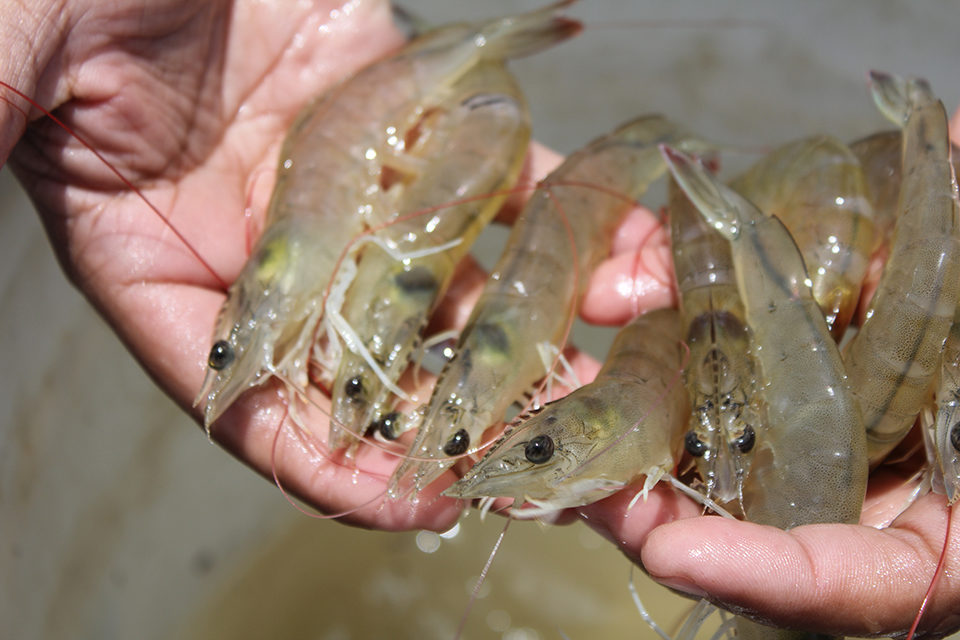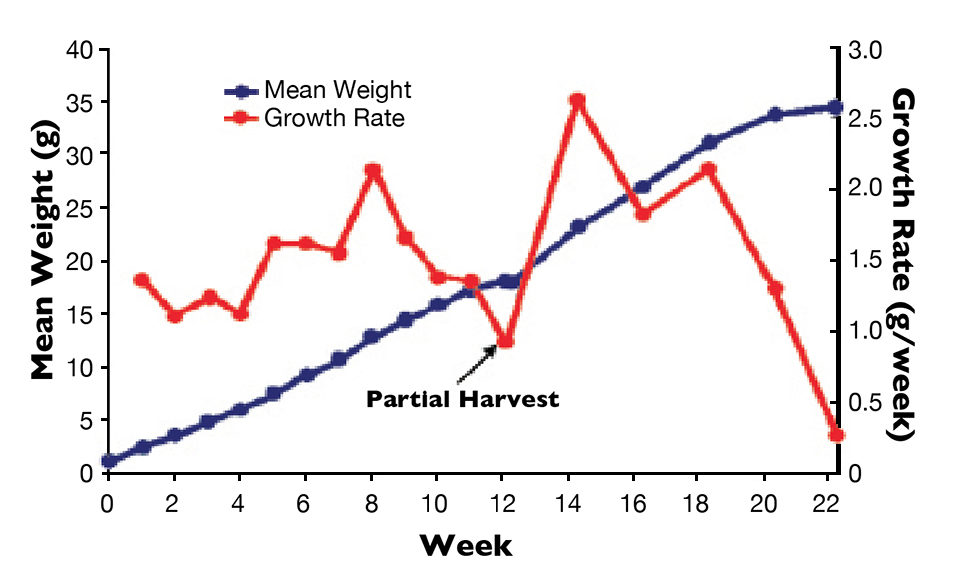Attention to small details can make a huge difference

Economic models of aquaculture production systems repeatedly indicate that profits are significantly improved as animal growth rates are increased. The capacity that a population of shrimp or fish has to grow is determined first by the animals’ genetics and second by the production system’s environment. When any of a number of environmental factors becomes suboptimal, the growth rate of the animals declines – and so will profitability.
With a clear understanding of compensatory gain, farm managers have the opportunity to reverse negative effects caused by shortcomings in the production environment and hopefully restore profitability levels.
Compensatory gain
Compensatory gain is defined as faster than normal growth following a period of slower than normal growth (Fig. 1). The physiological and biochemical reasons for this phenomenon are not clearly understood, but most, if not all, living organisms exhibit it. The primary cause is normally related to nutritional restriction, which can be correlated to many environmental factors, such as low or high temperatures, low oxygen levels, undesirable water chemistry parameters, unbalanced nutrition or simply underfeeding.

If the degree of the environmental stress is so severe as to permanently alter the animals’ physiology, they may exhibit some compensatory gain but never return to normal size (Fig. 2). However, if the environmental issue can be corrected and returned to a normal, steady state, the animals have the ability to “catch up” to the size they would be had no environmental problem occurred, provided the feeding level is increased to achieve the potential increase in weight gain.

Scientific studies
There is considerable literature on compensatory gain in a variety of animals, including fish. Studies on shrimp, however, are more limited. During the past 10 years, Chinese researchers have conducted various studies on compensatory gain in this species.
They studied food restriction, low protein levels, low water temperature and low oxygen levels. In all cases, the suboptimal conditions reduced growth rate, but upon restoring normal environmental conditions, the animals experienced compensatory gain and caught up to the control animals in four to six weeks.
The researchers observed that as feed intake declined due to the environmental conditions imposed, the animals first used up their reserves of lipid, followed by protein. In addition, they measured factors associated with a healthy immune system and found that as feed intake declined, so did the effectiveness of the immune system.
Practical examples
Data from Group Aquamaya’s farm in Guatemala that compares the growth rate of shrimp maintained in a nursery system for three weeks before stocking into ponds with the growth of animals that were directly stocked is presented in Fig. 3. The growth of the animals in the nursery ponds was quite slow because of intentional crowding.

It was estimated that at the end of the nursery period, these animals weighed approximately 0.3 grams each, whereas the direct-stocked animals weighted approximately 3.0 grams each. However, after four weeks, both populations weighted approximately the same.
Data from the Oceanic Institute in Hawaii for a super-intensive raceway stocked at 705 animals/m3 are presented in Fig. 4. Good growth was achieved through week six, after which it declined because of the high density/biomass. At week 12, when a partial harvest was performed, the growth rate of the animals increased markedly, but gradually declined as the biomass continued to increase.

Proper feeding
In the above two examples, improved growth rates as a result of compensatory gain were able to occur because the environmental issues were corrected or materially improved, and the feed rate was increased, which allowed the latent potential for growth to be expressed.
The expected increase in growth rate must be anticipated and the feed rate appropriately adjusted. Feeding a pond of shrimp that has the potential for compensatory gain at a constant percentage of body weight, a frequent practice in the industry, will not provide enough feed to take advantage of the opportunity, and the potential for profit will therefore be lost. In addition, there will be greater crop risk due to the increased length of time in the ponds and potential compromise to the animals’ natural immune systems.
Research
Compensatory gain can have significant effects on the results of scientific experimentation, so appropriate consideration is advised. If the animals used are crowded prior to or during experimentation, held in an undesirable environment or subjected to other conditions that cause a reduction in nutrient intake, their physiological processes, including their immune systems, can be compromised. Accordingly, studies of enzyme activity, body composition or diseases can result in skewed or inaccurate conclusions.
If the experimental animals used are in the recovery period and experiencing compensatory gain, the faster rate of growth would potentially be helpful in the resolution of treatment differences, especially in nutritional studies. However, if those who interpret the data assume the rate of growth during the compensatory gain phase represents normal growth, they would achieve misleading results.
Perspectives
Attention to small details can make a huge difference in the success of aquaculture production systems and research studies, and compensatory gain is one of these details. It is important to understand when this phenomenon is or could be occurring, and to develop preplanned strategies to take advantage of the opportunities for increased growth rate afforded by compensatory gain. Feeding strategies must supply adequate feed to feed the animals to satiation during the recovery or compensatory gain phase.
Bottom Line: Improve profits by effectively managing compensatory gain.
(Editor’s Note: This article was originally published in the May/June 2012 print edition of the Global Aquaculture Advocate.)
Author
-

Thomas R. Zeigler, Ph.D.
Senior Technical Advisor
Past President and Chairman
Zeigler Bros., Inc.
P. O. Box 95
Gardners, Pennsylvania 17324 USA[109,111,99,46,100,101,101,102,114,101,108,103,105,101,122,64,114,101,108,103,105,101,122,46,109,111,116]
Related Posts

Intelligence
We can grow better shrimp, and in better ways
The recent Central American Aquaculture Symposium in Choluteca, Honduras, brought together more than 600 participants to discuss industry issues and perspectives. The focus was shrimp diseases and their impacts on production, as well as practical alternatives to face these issues and move forward.

Health & Welfare
Building a better shrimp nursery, part 1
Shrimp nursery systems offer an important opportunity to increase profits. Properly designed and operated nurseries are highly biosecure facilities to grow postlarvae at very high densities.

Aquafeeds
Aquaculture Exchange: Dr. Tom Zeigler
The World Aquaculture Society’s latest Lifetime Achievement Award recipient reflects on 50 years in the business of producing high-quality, nutritious feeds for the poultry, livestock and aquaculture industries.

Intelligence
Biofloc technology production promising in temperate zones
A study was conducted to assess the feasibility to grow Channel catfish (Ictalurus punctatus) in an outdoor biofloc system during winter in a temperate zone. High biomasses of market-size channel catfish were successfully maintained through the winter with high survival and in good condition in both treatments.

